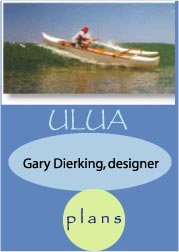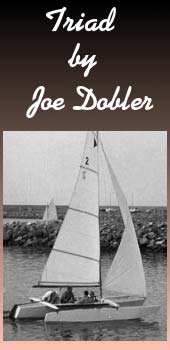
 Custom Search
|
|
| sails |
| plans |
| epoxy |
| rope/line |
| hardware |
| canoe/Kayak |
| sailmaking |
| materials |
| models |
| media |
| tools |
| gear |
 |
 |
| join |
| home |
| indexes |
| classifieds |
| calendar |
| archives |
| about |
| links |
| Join Duckworks Get free newsletter Comment on articles CLICK HERE |
|
|
| "Build A 15 Mph Boat For Under $1500?" - Pt. 2 |
By Frank B. Smoot - Florida - USA |
|
Fortunately, not everything I built was quite so laughable. My first boat to crack the 10 mph barrier was a catamaran with 14 ½ foot hulls. It was powered by an 84 sf sail, which we still use on Laura's tri (though I had to make an aluminum mast to replace the original wooden mast that snapped like a twig in the middle of the bay.) That cat wouldn't come about worth squat, but it was really quick and quiet in a straight line.
Even better, Laura and I could both sit on the "bench" seat, side by side and facing forward, not fore-and-aft like on most boats. And from our bench, either of us could foot-steer using the pivoting, deck-mounted steering bar (one of my stranger inventions, harkening back to my homemade go karts). For reasons I can't fully explain, I absolutely hate tillers. I also hate sitting sideways in a boat that's going forward. I much prefer to do what multihull guru Jim Brown calls "armchair sailing." And with my (sadly belated) discovery of those amazing things called cam cleats, I can now cleat off the main sheet and comfortably eat my lunch in my tri, while zipping along - hands free - at 13 mph. How cool is that? Well it's darn cool…unless your mast step pops out through the side of your hull and you get all wet. Did I mention that DIY boat building involves a bit of a learning curve, especially if you are also the "designer?" Even though the hull on my tri was pretty well built, I suffered what engineers call a "catastrophic failure" of the mast step because I had seriously underestimated the lateral forces it would have to deal with. I later read (in C. A. Marchaj's book Sail Performance) that, when sailing close hauled, for every pound of forward force generated by a sail, it can generate as much as four pounds of lateral force. Hmmm…that would be a good thing to know before you design your boat… I love unstayed masts for so many reasons, but they definitely require a different kind of support structure than masts with shrouds. The deck of my boat had been reinforced to handle quite a lot of lateral thrust, but the attachment of the step was, in hindsight, shamefully inadequate. Fortunately, my wife's boat, which I built not long after my own, had much sturdier mast steps (yes, plural). Actually, all my boats now have more than one place to step the mast. In fact, my own tri now has two holes to plug in unstayed masts, and two tabernacles.
Why so many mast location options? Partly because the various rigs I use have all different centers of effort. And partly because I sometimes want to use a sail on an unstayed mast with a jib, which means moving the main sail aft so the jib doesn't cause horrendous lee helm. But mostly I have so many mast location options because everything I make at this point is experimental - and I freely confess that I just don't know in advance where's the best place to put the mast to balance the handling. I can only discover that through trial and error. Lots of trial, lots of error. It's still something of a mystery to me why I thought that wimpy mast step I put in my boat would do the job. But I suspect the hull blowout had something to do with upgrading to a 102 sf sail, which was much more powerful than the sails I originally intended to use. But that's just how it goes in the quest for ever more speed. Bigger sails, sleeker hulls, planing amas…and learning experiences. Lots and lots of learning experiences. Snapped masts, failed rigging, broken rudders, falling spars... But then, that's what hands-on experience is all about. Another thing I didn't grasp early on is that every improvement you make changes the whole dynamics of the boat. Bigger sails mean more lateral thrust, not just on the mast step and partner, but also on the amas and the cross tubes (akas) that attach the amas to the main hull. The very first amas I made *seemed* like they would provide more than adequate buoyancy to keep the boat upright. And for a while, they did. But as my sail size increased (74 sf, 84 sf, 102 sf, and even 124 sf for the Laser II rig, I started to "bury" the old amas on a regular basis. In my view, that's a bad thing, because when your ama goes far enough underwater to submerge the cross tubes, it feels exactly like slamming on the brakes in your car. Ain't ever gonna see 15 mph that way!
So there was no getting around it. I needed bigger and better amas. Now, I know that some designers consider it a "safety factor" to make amas that will submerge under high strain, thus preventing the hapless trimaran pilot from getting into trouble or "pitch-poling" due to excessive speed. But heck, excessive speed was my goal! That's why I ended up designing a pair of planing amas that not only had 800 lbs of flotation, but actually rose higher out of the water the faster they went - just like a powerboat! Now, I'm the first to admit that my 2 ½ years of sailing and my 2 years as a "designer" don't remotely qualify me as an expert. Truth is, I still learn something new every day, either by actually sailing, or by surfing the net. I still remember how delighted I was to stumble across the Duckworks website and its bounty of free info from real experts. You can even find slick inventions like an auto-release locking cleat, which has relieved both Laura and me of endlessly checking the kick-up rudders to see if they had accidentally kicked up unnoticed from all of our high-speed sailing. Luckily, I get to do quite a bit of high-speed sailing. Not only do we live 10 minutes from sailable water, we also live on Florida's Gulf Coast, where I can sail all year round! And the old adage that boats are enjoyed in inverse proportion to their size is certainly true. The shorter (and lighter) a boat is, the more often you'll find an excuse to take it out. That's why our boats were built to weigh as little as possible. My center hull tips the scales at about 90 lbs, and Laura's tri (which I built after mine) weighs just 65 lbs. All up, her boat weighs just 130 lbs! Interestingly, I once saw a trimaran manufacturer's "promotional" video where they seemed to be quite proud that they could get their boat rigged and ready to go in "just 45 minutes." No way in the world could I spend that much time rigging (and de-rigging) every time I wanted to sail. With my little tri, I can be sailing 14 minutes after I get to the beach! Heck, even someone with my highly impatient nature can live with 14 minutes! And Laura can rig her boat by herself in the same amount of time, which is handy, as both boats live on the same trailer.
Oh, and before I forget, here's one more great benefit of hands-free sailing: Laura was able to take the video of my boat going about 12 mph while her boat was going very nearly as fast! Try doing that with one hand on the tiller, the other on the main sheet, and a third had trying to brace yourself upright as your monohull's chine starts to dip into the bay. I have to say, I just love multihulls. Though some builders of "traditional" boats look down their noses at my little tri, they also look at my wake whenever we sail together. And when my little tri came in first at a local small craft fest race - and my wife's came in second - well, we didn't win any popularity contests. I honestly don't mean to bash monohulls. Some of my best friends have them and love them. They're simply not my cup of tea for all the reasons cited above. Plus, I think us multihullers simply have different priorities. We probably aren't as attached to tradition, we might just be too lazy to work at keeping a tippy boat upright, and we definitely like to have the option of going fast. (Of course, if you consider that Pacific islanders have been building their amazing boats for a few thousand years, maybe us multihullers are being pretty "traditional" after all.) Ultimately, small trimarans just seem to provide the most bang for the buck. I never get tired of the thrill of feeling that burst of acceleration in the small of my back as the wind fills the sail and my little tri starts to really move out. I sit comfortably, my eyes forward, my feet doing the steering, my hands free, and my senses wonderfully filled with the joys of silently skimming across the water. If sailing gets any better than this, well, I'm not sure I want to know about it. The End |
 |